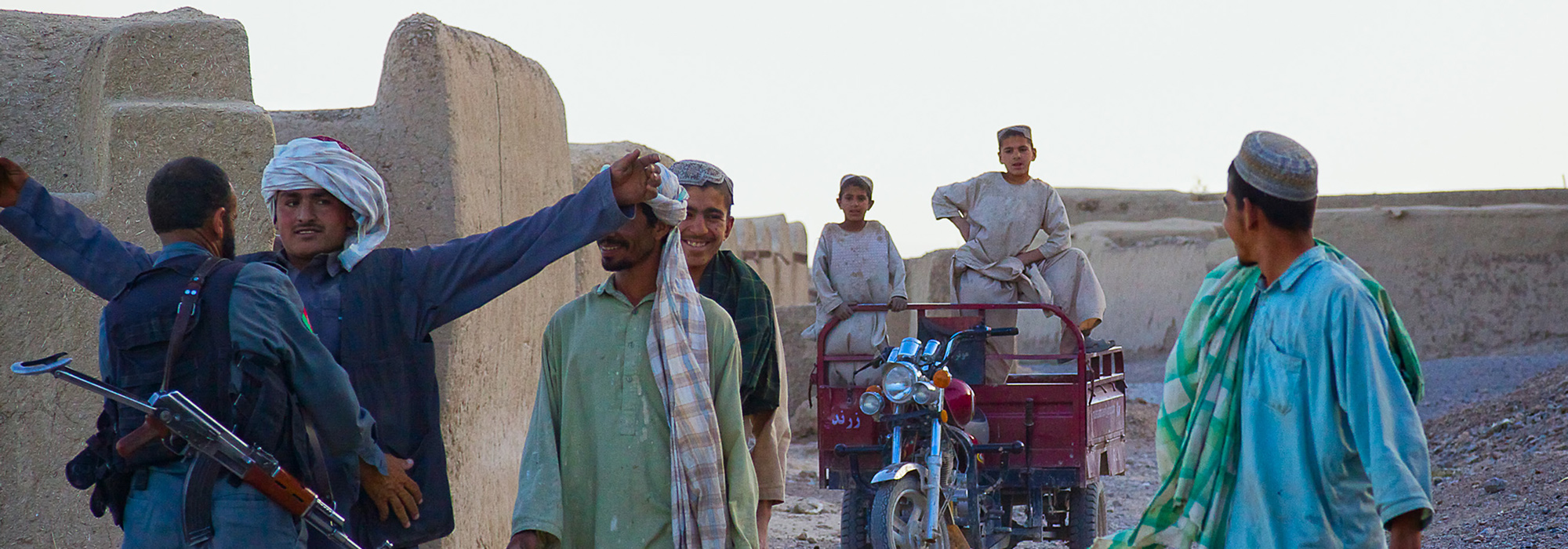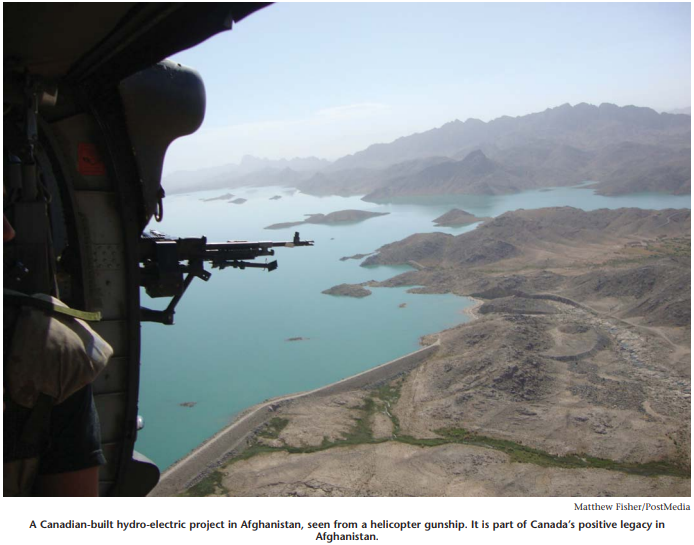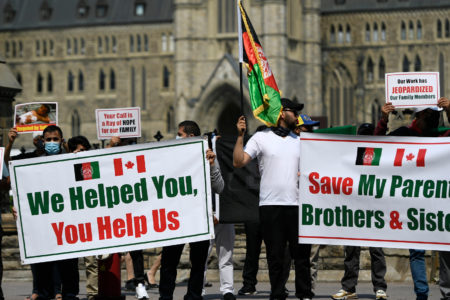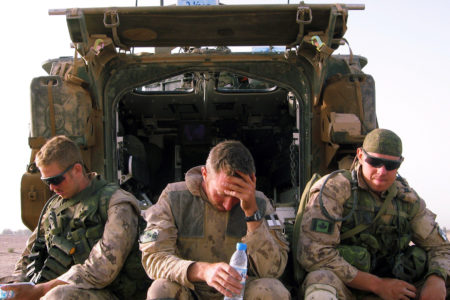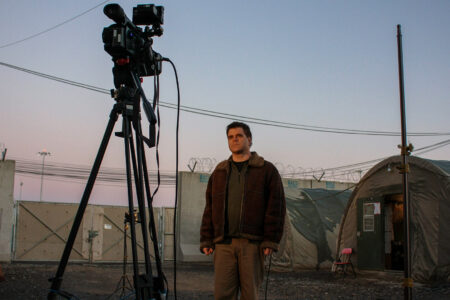
Ten months into my posting as a foreign service officer to Kandahar, I was on a helicopter with American soldiers of the 82 Airborne on the way to the Arghendab District. The doors of the helicopter were open, affording a full view of the ground below. As we passed over a patch of field not particularly different from the rest, I heard the pilot say “Tarnak” through the headset. It was clear from the faces of my fellow passengers that most did not recognize the word. To Canadians, however, Tarnak means a great deal. Formerly a training field, Tarnak was the sight of the air-to-ground friendly fire accident in the spring of 2002 that killed four soldiers: Sergeant Marc Leger, Corporal Ainsworth Dyer and Privates Nathan Smith and Richard Green. The lack of recognition by my fellow passengers is forgivable — a by-product of living in a conflict zone where so much happens in a day it feels like a week, and where a steady state of insecurity makes self-preservation the immediate concern.
Looking down at what must have been close to the exact trajectory of that errant missile, I thought back to the day of the accident almost a decade earlier. In an entirely different job as political press secretary to the minister of national defence, I was tasked to communicate the accident publicly in what would become a series of unfortunate events that all Canadians are familiar with: next-of-kin notifications, ramp ceremonies and statements of condolence.
The cost of this mission is now well known: at the time of writing, 157 soldiers, 2 aid workers, a diplomat and a journalist have died. Countless more Canadians have returned wounded, inside and out.
It would be impossible to discuss Canada’s legacy in Afghanistan without speaking to that loss. I have carried the weight of one of those caskets during a ramp ceremony in Kandahar. It was for a woman about my age. It is a weight that never leaves you. Perhaps it is only right that what haunts individual Canadians returning from the field should be what is reported by the media and leaves its mark on the public consciousness of all Canadians. Undoubtedly, those are stories of loss. However, a lot has changed in Afghanistan over the past 10 years that speaks to the cause, and not just the cost.
Tarnak Field is now Tarnak Farms — it has been repatriated to the people of Afghanistan and is now a wheat farm. This is partly due to the hard work of Canadian soldiers and development officers. In late May, Prime Minister Stephen Harper walked through the wheat field and declared victory against Islamic terror in Afghanistan. As the last combat troops drew down in Kandahar over the summer, it was being debated whether this was a legitimate boast about Canada’s accomplishments in Afghanistan.
The response from those who have had experience on the ground is typically much more measured. Following a successful “clear” operation to remove insurgents or the completion of a development benchmark, for example, officers on the ground, both military and civilian, will often say that it is up to the Afghan government to consolidate these gains. Translation: While we can set the conditions for success, winning is not up to us but up to the government of Afghanistan, which all efforts are ultimately intended to support.
The heart of Canada’s counterinsurgency campaign in Afghanistan, commonly called COIN for short, eventually became the approach shared by all serious nations contributing to the International Security Assistance Force (ISAF) in Afghanistan. Premised on the fact that it is nearly impossible to kill off an insurgency, it combines military forces and civilian efforts in order to contain the insurgency and address its root causes. Success in this type of campaign is difficult to measure and cannot be pronounced with a conventional declaration of victory. The goal is twofold: to weaken the insurgency and strengthen state structures.
In the spring of 2010, as US President Barack Obama shifted attention from Iraq to Afghanistan and a protracted public debate raged in the US over the resources that would be dedicated to the war, Task Force Kandahar, under Canadian command and armed with one battle group and little more than two American units, would hold Kandahar City. Canada’s efforts in the lion’s den under the hand of General Jon Vance would prove critical in abating the growing influence of the insurgency in the south at a crucial time for the country. Those of us on the ground watched the protracted American debate closely and at times irreverently, as unnamed Pentagon officials quoted in the Washington Post would say that there were “no resources in Kandahar City,” while we were sitting there. Regardless, it was clear that the public comments and appearances by General Stanley McChrystal — the former commander of NATO forces in Afghanistan tasked with providing the US president an assessment — were intended to secure much-needed resources. It was a huge relief to finally see these resources arrive with a surge of 30,000 troops and hundreds of civilians. Moreover, the US would adopt the counterinsurgency strategy Canada was already executing in Kandahar.
The unique lessons in Kandahar have been hard won. Tribal dynamics, years of corruption and the irregular warfare propagated by the Taliban, which focuses on high-profile attacks on soft targets and improvised explosive devices (IEDs), have taught some bitter lessons.
It is interesting to note that it was also under General McChrystal — who was later fired over comments his aides made about the Obama White House — that the US sent an unprecedented surge in special forces to Afghanistan to focus on “high-value” targets.
The Canadian military executed a counterinsurgency campaign to secure Kandahar and its approaches, including Zhari, Panjwaii and Arghandab districts, while Canadian civilians worked out of the Provincial Reconstruction Team (PRT) in the middle of the city to try to help strengthen local and provincial governance. Prioritizing the need to protect the Afghan population from Taliban reprisals while helping the government to provide basic services ultimately meant the effort would be focused not in unpopulated areas of the province as in the past, but in the city, where 85 percent of the population lives. COIN was the wartime equivalent of moving from zone defence to man-to-man combat.
At the time, some accused NATO of retreating to the walls of the city, but in reality it was the only strategy that would counter an insurgency that focuses on hitting high-profile, largely civilian targets. COIN ultimately attempted to address the conditions that the Taliban and al-Qaeda had used to their benefit in the first place: threat and intimidation by the Taliban, poverty and a total absence of human rights.
By the time the US arrived in Kandahar province in force, Canada had years of experience to share. The challenges of protecting the population from insurgent threat while supporting local government in delivering basic services was in some ways a natural evolution of Canada’s past military interventions, in which Canadian men and women placed themselves between the aggressor and the local population in order to give people the stability they needed to improve their lives. However, the unique lessons in Kandahar have been hard won. Tribal dynamics, years of corruption and the irregular warfare propagated by the Taliban, which focuses on high-profile attacks on soft targets and improvised explosive devices (IEDs), have taught some bitter lessons.
Despite a political debate in Canada that has often described this engagement as departing in an overly American way from past Canadian interventions, COIN shares this basic tenet with a previous Canadian intervention labelled the “responsibility to protect,” or the 3D approach, incorporating defence, diplomacy and development. Further, American units have actually been under the trust of Canadian command in an unprecedented way, introducing the US military to the way we conduct both civilian and military activities abroad.
In the field, military commanders execute counterinsurgency tactically in all operational planning using the “clear, hold, and build” phases. Soldiers clear an area of insurgents, hold and guard it from threat with their lives, so that development organizations working through local Afghans can move in and build. It is well known that Canada’s area of operations, Kandahar City — spiritual home of Taliban leader Mullah Mohammad Omar and the focus of Taliban efforts — has been the toughest in the entire country ti clear.
What is less well known is that the fight has been equally tough if not tougher on the development side. Canadian aid principles have traditionally been based on “sustainable” development — in other words, progress that would continue once Canadians were no longer in the country. For that to happen, a bare minimum amount of community buy-in is required. This is a challenge in a country that is rife with corruption. Getting legitimate buy-in can take months, even years of relationship building. There is evidence that it does matter. A recent study indicated that almost 10 percent of the money that goes toward quick-impact projects — seen as the opposite to sustainable projects — actually ends up in the hands of the Taliban itself. In other words, it is possible that Canada could find itself paying local Afghans to rebuild a bridge that they had some part in blowing up in the first place.
Canada’s development principles dictate that how it’s done is more important than getting it done quickly; for the military, at times it is necessarily the opposite.
If you are the soldier holding ground from insurgent attack and clearing dirt roads of IEDs, looking over your shoulder, waiting for concrete to be laid, you want it done in double-quick time. Hearing that a UN-sponsored road program is waiting for a letter from the mayor of Kandahar is not merely frustrating for a commander, it is a matter of life and death. Not surprisingly, there is tension between the military and civilian agencies working both sides of this coin. The job of hashing it out through close military and civilian integration, while living in the same tent every day in Kandahar, fell to countless soldiers and civilians, corrections and foreign service officers, and development officers, all seeking to find the right balance. For many reasons, the whole-of-government approach is a side of the story that has not been told, but for the sake of future engagements, it should be remembered.
There is reason to believe the whole-of-government approach works. If anything will have traction in Kandahar in the years to come, it will be the Dahla Dam project. The $50million project has garnered much attention and has not been without controversy. Dahla demonstrates the success of working in a civilian/military concept, and is a classic example of sustainable development that has managed to gain community buy-in. Lisa Vandehei, the Canadian manager of the project for much of its life, has often described the need to “measure twice and cut once,” and it has gradually delivered results. The first phase has been fixing the pre-existing dam. Further work is clearing silt out of miles of irrigation canals that flow through villages; usable water for farming has increased by up to 80 percent and the water has begun to flow. There is every reason to believe that this will continue once Canadian officials leave the south. This is due in large part to the level of support Canada sought locally. For the past eight years, Afghan officials with the Energy and Water department in Kandahar, have repeatedly risked their lives to see the benefits of Canada’s investment come to fruition. In the case of Dahla, success was due in part to the fact that basic machinery of government worked — namely effective local officials and a supportive Ministry in Kabul.
For their part, the Taliban’s campaign aimed at preventing exactly this kind of progress to undermine Afghan will and international will has been effective. With very few conventional resources, which include weapons, the Taliban can undermine security with one visible attack. In focusing their efforts on attacking high-profile civilian targets, they have become experts at multiplying the fear these attacks cause, by dominating what ISAF calls the information battleground. By all accounts, locally their message gets out first and farthest. If “the medium is the message,” the Taliban have a highly effective powerful medium — extremely violent, asymmetrical assaults.
During one of my last operational briefings, I listened to the details of the assassination of a local elder by the Taliban. The elder was known to welcome reconstruction and development in his village. Insurgents hanged him from a tree and planted eight IEDs in the ground below his body. This was to warn off local sympathizers and/or hit secondary responders who might try to cut him down. The message was obvious and would travel faster than any technology NATO could offer. Public hangings, reprisals and night letters are commonplace.
The Taliban generally use two people as their spokespeople: Qari Youssef and Zabullah Mujuahid. Zabullah is widely believed to be a nom de guerre — one that several Taliban voices have been known to use.
Every spring the Taliban launch a series of attacks on high-profile targets. This past May, they attacked the governor’s palace, the Ministry of Interior and other sites. In May 2010, they attacked Kandahar Airfield, and the month before, Bagram Airbase. In Bagram, less than a dozen Taliban insurgents attacked the base at dawn. Twenty minutes into the attack, Zabullah Mujuahid called a CNN journalist, apologized for waking her up, said that they were attacking Bagram and asked for coverage. CNN sent a camera. On May 23, they attacked Kandahar Airfield. In both cases, the attacks were characterized as bold attacks on ISAF’s largest military installations in Afghanistan. Bold as they were, the attacks amounted to bee stings in a military sense — in the case of Kandahar Airfield, the insurgents did not even breach the north fence. The win, however, was in the coverage itself. Over and over again, through threat of asymmetric attack, the Taliban would project a fear much more powerful than their actual conventional strength.
The Taliban are also extremely focused in their messaging. Less than 2 percent of Kandaharis have access to the Internet, and the literacy rate is roughly 28 percent. A message intended for the international community, such as one responding to a high-profile Taliban loss, is posted on Web sites. However, a message intended for local Afghan audiences — usually threatening reprisal — is communicated via local radio. During the 2009 presidential election, the Taliban said that any Afghans found voting would have their thumbs cut off. In the end, there were only two reported cases of such punishment being meted out. But the effect of these threats on voter turnout was obvious — low turnout is one of the main reasons why the viability of the elected government of Afghanistan is questioned.
I asked an Afghan journalist based in Kabul, whose name can’t be used, how the Taliban have managed to best the Afghan government and ISAF in getting their message out. In the case of the government, he said, the “spokespeople have spokespeople.” By contrast, the Taliban respond quickly and have one nom de guerre, Zabullah. The journalist’s answer also points to the enormous bureaucracy surrounding communication. It’s a system of approvals for public comment suffered not just by Canada but by all ISAF contributing nations, who must deal with their respective capitals before making public comment. A further concern for operational security presents obvious delays and limitations on what context can be provided (even in this very article).
Interestingly, according to three consecutive reports by the Asia Foundation, in Afghanistan the media is becoming one of the most trusted institutions. While this may be faint praise, given the state of many other institutions, the fact that Afghans rate their media as up to 70 percent reliable is an achievement. It is also becoming increasingly professional — even in the south, where last year 70 young journalists voted themselves into a press gallery. Ironically it is one of the few institutions that are untouched by capacity building efforts. Rather, it has developed in large part due to the secondary effect of exposure to the countless foreign media that have infiltrated the country since the conflict began. Regardless of the reason, the Fourth Estate and its ability to bring accountability to both the government and the insurgency are positive forces. It is also increasingly dangerous to cover the Taliban as they make decisions that undermine their efforts. In March of this year Razaq Momoon, a prominent journalist and author in Afghanistan, was attacked by unknown assailants, who threw acid on his face.
This is not to say that the Taliban do not have successes in the field that do in fact undermine security, such as the escape from Sarpoza prison in April. Corrections Canada has done a tremendous amount of work in training guards and bringing the prison as close to United Nations standards as possible, in a country that the UN itself names as the second-worst place on earth. Yet in April, 475 purported Taliban escaped through an underground tunnel to a house across the street, and it is widely believed that the guards were complicit, if not outright helpful.
I met with the warden of Sarpoza prison and one of Canada’s corrections officers, who had some good news to deliver to the warden: there would be help in bringing salaries for his guards on par with those of the Afghan National Police and the army. The warden was relieved. In this environment, salaries have a direct impact on both recruitment and retention. Poor salaries make officials susceptible to bribery. For Afghans, even entering Sarpoza prison is not for the faint of heart. Interpreters enter fully covered to protect their identity from the prisoners, out of fear of retribution by the Taliban. On a daily basis, prison guards at Sarpoza face regular criminals and the Taliban. In this environment, guards must try to feed and protect their families. To do both, all they have to do is look the other way. Not surprisingly, they do.
The experience of Sarpoza shows that NATO’s efforts to boost the institutions of Afghanistan can depend on relatively mundane concerns like salaries and the ability of the machinery of government to pay them. It is a challenge across all Afghan line ministries and it affects teachers, the Afghan National Army, the Afghan National Police and more. Canada can work through local NGOs to build schools and train teachers, but ultimately it is up to the government of Afghanistan to give teachers a reason to believe it will sustain them.
On September 11, 2001, I was working in the office of the minister of defence in Ottawa. That morning, I answered 70 calls from journalists. Without exception, press had two questions. Who did this and why? At dawn the next morning, I was called into a meeting and heard Osama Bin Laden’s name for the first time. I also learned, that the al-Qaeda network, built and housed under the Taliban regime, was a well-known and growing threat in Afghanistan, one that festered in conditions that in many cases still exist today in the region. The removal of the Taliban regime from power and the elimination of Bin Laden close the chapter on the first question. However, the conditions that made his existence possible still exist, and work must continue. After a decade of Canada doing its part, of which we can certainly be proud, most of that work is now out of our hands and rests with the government of Afghanistan.
Photo: Nate Derrick / Shutterstock



